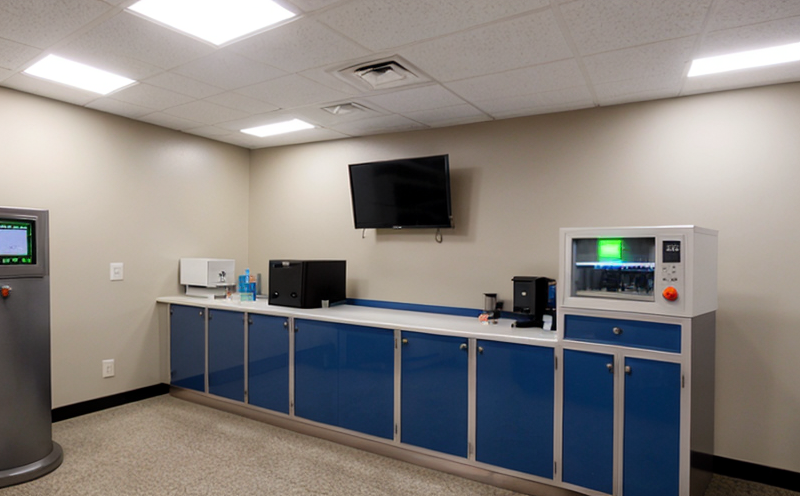ASTM C1001 Gamma-Ray Spectrometric Assay of Iodine-131
The ASTM C1001 method is a critical analytical technique used for the quantitative determination of iodine-131 (I-131) in various pharmaceutical and medical products. This test plays an essential role in ensuring the quality, safety, and efficacy of radiopharmaceuticals that rely on I-131 as their active ingredient or tracer.
Iodine-131 is a short-lived radioisotope with a half-life of approximately 8 days. It is primarily used in diagnostic imaging (such as thyroid scans) and therapeutic applications, including the treatment of hyperthyroidism and certain types of cancer. The accurate measurement of I-131 activity concentration is crucial for both patient safety and regulatory compliance.
The ASTM C1001 method employs gamma-ray spectrometry to analyze samples. Gamma rays are emitted when iodine-131 undergoes beta decay, converting into xenon-131. This process releases a characteristic energy spectrum that can be detected and analyzed by the spectrometer. The technique is highly precise, capable of measuring I-131 activities down to the picocurie (pCi) level.
The method specifies detailed procedures for sample preparation, including the use of appropriate vials or containers to minimize gamma-ray attenuation during measurement. Calibration with known standards ensures accurate results. The ASTM C1001 protocol also includes guidelines on data acquisition and analysis, which are essential for interpreting the spectral data correctly.
Given the short half-life of I-131, it is important to conduct the assay as soon as possible after sample preparation. This minimizes the impact of radioactive decay on the measurement results. The method also accounts for potential interferences from other isotopes that may be present in the sample matrix.
Accurate and reliable analysis of I-131 using ASTM C1001 is vital for several reasons:
- To ensure compliance with regulatory requirements, such as those set by the International Atomic Energy Agency (IAEA) and the United States Nuclear Regulatory Commission (NRC).
- To provide consistent and reproducible results across different batches of radiopharmaceuticals.
- To support quality control processes in manufacturing facilities that produce I-131-containing products.
- To enable accurate dosimetry calculations for therapeutic applications, ensuring the right dosage is delivered to patients.
The ASTM C1001 method is widely recognized and accepted by regulatory bodies worldwide. Its standardized approach ensures uniformity in testing across different laboratories, enhancing confidence in the results obtained.
Understanding the intricacies of this analytical technique requires a thorough knowledge of radiation physics and spectrometry principles. Our team of experts brings extensive experience in performing ASTM C1001 analyses, ensuring that each test is conducted with precision and accuracy.
Why It Matters
The importance of the ASTM C1001 gamma-ray spectrometric assay cannot be overstated. In the realm of radiopharmaceuticals and medical isotopes like iodine-131, accurate measurement is paramount for several reasons:
- Regulatory Compliance: Regulatory bodies, such as the FDA and EMA, require stringent testing to ensure that products meet safety standards. Failure to comply can lead to product recalls or legal action.
- Patient Safety: Ensuring accurate I-131 concentrations helps prevent overexposure or underdosing, which could have serious health implications for patients undergoing treatment or diagnostic procedures.
- Quality Assurance: Consistent and reliable testing ensures that each batch of radiopharmaceuticals meets the required quality standards. This is particularly important in ensuring the efficacy of therapeutic applications.
- Data Integrity: Accurate measurements provide essential data for research, development, and clinical trials, supporting advancements in medical technology and treatment protocols.
The ASTM C1001 method provides a standardized approach that ensures consistency across different laboratories. This standardization is crucial in maintaining the integrity of testing results and fostering trust within the industry.
Applied Standards
The ASTM C1001 gamma-ray spectrometric assay adheres to the standards set by ASTM International, which are widely recognized for their technical expertise. The method is based on international standards such as:
- ISO 5738: This standard provides guidelines for the general requirements of nuclear instrumentation and techniques.
- ASTM C1001: Specifies the procedure for determining I-131 activity concentration in pharmaceuticals by gamma-ray spectrometry.
- EN 45287: This European standard outlines requirements for measuring radioactivity in environmental samples, which can be relevant when considering broader radiation safety protocols.
These standards ensure that the testing process is robust and reliable, providing a framework for accurate and consistent results. Compliance with these standards also facilitates international cooperation and recognition of test results across different jurisdictions.
Industry Applications
The ASTM C1001 gamma-ray spectrometric assay has numerous applications within the medical and pharmaceutical industries, particularly where I-131 is used. These include:
- Radiopharmaceutical Production: Ensuring that each batch of radiopharmaceuticals contains the correct amount of I-131 for effective treatment or diagnosis.
- Treatment Monitoring: Providing real-time data on I-131 activity in patients undergoing therapy, ensuring accurate dosimetry and minimizing radiation exposure.
- Research and Development: Supporting the development of new radiopharmaceuticals by providing precise measurements for dose optimization and efficacy assessment.
- Quality Control: Implementing quality control measures to ensure that products consistently meet regulatory standards and patient needs.
The method is particularly useful in diagnostic imaging, where accurate I-131 concentrations are crucial for generating clear images of the thyroid gland. In therapeutic applications, such as the treatment of Graves' disease or cancer, precise dosimetry ensures optimal treatment outcomes while minimizing side effects.
Our laboratory uses ASTM C1001 to support these industry applications, ensuring that each test is conducted with the highest level of accuracy and precision.





